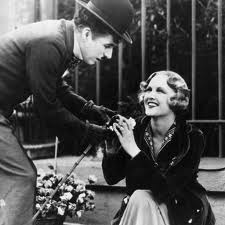City Lights

That Tramp just can’t get a break, can he?
Most of the time, Chaplin’s Tramp appeals to me because he manages to hold his own in a world that couldn’t care less about him. Paradoxically, City Lights works so beautifully because in it, the harder the Tramp tries, the harder he gets knocked down. Usually, Chaplin manages just the right amount of pathos, so that it doesn’t seem overdone. Here, it’s nothing but overdone – and you can’t help responding to it.
That’s certainly not to say that the movie is without its laughs. It starts right off with Chaplin figuratively doing what he’d had to do literally for the previous two years: Battle the talkies. He had started filming City Lights when the talking-film revolution took hold. But Chaplin had the clout to remain Hollywood’s sole holdout – he would continue making the movie as a silent picture. And the movie’s opening scene shows him thumbing his nose (literally, at one point as the Tramp) at sound, as some city officials unveil a statue, but not before making a pompous speech to the soundtrack accompaniment of withering kazoos. When the statue is unveiled, it holds the Tramp in its arms – he was just looking for a place to sleep.
Eventually, the Tramp comes across a blind flower vendor (Virginia Cherrill) and is entranced enough by her to return as a regular customer. The Tramp also has the good/bad luck of coming upon a drunken rich man (Harry Myers) who is attempting suicide at the nearby river after his wife has left him. The Tramp talks him out of it (but not before the two of them get dunked a couple of times), and the rich man declares the Tramp as his lifelong friend. Trouble is, the eternal friendship lasts only until the rich man’s alcoholic buzz wears off, at which time he forgets he ever knew him. What’s a tramp to do?
I will surely earn the enmity of Chaplin buffs by saying this, but as much as I enjoy this movie, I don't find it flawless. I have trouble with a couple of the movie’s elements. First – and I’m sure this will sound too persnickety for words – I think Chaplin is too heavily made-up in this movie. We’re all familiar with the Tramp’s iconic big eyebrows; here, they’re way overdone, and Chaplin’s eyes are overly mascara’d. It’s as though he’s going out of his way to hedge his bets in winning sympathy for the Tramp as a pathetic figure. (If you doubt me, check out Chaplin’s close-ups in the party scene at the rich man’s home.)
The biggest problem I have with this movie is that I have to stretch credulity a long, long way to believe that this rich man wouldn’t have any recollection of the Tramp once he’s sober, and then he’d instantly recognize him again the next time he gets drunk. I’ve had my share of plastered moments, so I know that memory loss is quite plausible. But to not remember the guy who saved you from killing yourself? the guy you went out partying with every time you tied one on? There are worse leaps of logic in the history of cinema, to be sure, but in Chaplin’s case, this is a pretty wide berth.
But if you can get past those two formalities – and generations of filmgoers have certainly had no problem doing so – you’ll be treated to one of moviedom’s finest pleasures. And after three-quarters of a century, that stripped-to-the-core acting between Chaplin and Virginia Cherrill at movie’s end still leaves viewers at least wide- , if not teary-eyed. (The marvelous documentary Unknown Chaplin explicitly details how exasperated Chaplin was in trying to get a decent performance out of Cherrill. You’d never know it from the final product.)
Sometimes you just want that all-out sentiment, like a good ballad or tearjerker. City Lights is surely what Woody Allen meant when he referred to “the good sentimental.”
Click here to return to:
HomepageFilmography